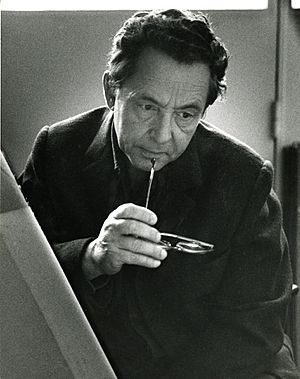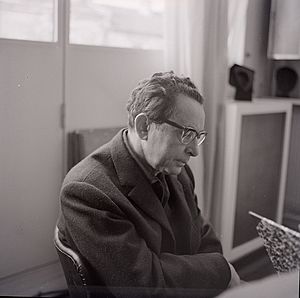Hans Hartung facts for kids
Quick facts for kids
Hans Hartung
|
|
|---|---|

Hans Hartung, photo by Paolo Monti, 1960 (Fondo Paolo Monti, BEIC)
|
|
| Born | 21 September 1904 |
| Died | 7 December 1989 (aged 85) |
| Nationality | German-French |
| Movement | Tachism, Lyrical Abstraction |
| Awards | Venice Biennale Grand Prix |
Hans Hartung (born September 21, 1904 – died December 7, 1989) was a famous German-French painter. He was known for his special style of abstract art, where he used bold, sweeping brushstrokes. He was also a brave soldier in World War II and received an important award called the Legion d'honneur.
Contents
Hans Hartung's Early Life and Art
Hans Hartung was born in Leipzig, Germany. His family loved art, and he grew up enjoying the works of old masters like Rembrandt. He also liked German painters such as Lovis Corinth and the Expressionist artists Oskar Kokoschka and Emil Nolde.
In 1924, he started studying philosophy and art history at Leipzig University. Later, he went to the Fine Arts academy in Dresden. There, he copied paintings by famous artists to learn their techniques.
In 1926, Hans saw modern French and Spanish art at an exhibition in Dresden. This art really inspired him. He decided to leave Germany so his art wouldn't be limited by local styles. After a bike trip through Italy, he moved to Paris, France.
Life in Paris and New Ideas
In Paris, Hans Hartung mostly worked alone. He kept copying old and new master paintings. He also visited the south of France, where the beautiful landscapes inspired him. He studied the works of Paul Cézanne, a famous painter, and became very interested in ideas about harmony and balance in art.
In 1928, he went to Munich to learn more about painting techniques. The next year, 1929, he married another artist named Anna-Eva Bergman. They lived in French towns like Leucate and then moved to the Balearic Islands in Spain, settling in Menorca. His first art show was in Dresden in 1931.
Facing Challenges and War
In 1932, Hans's father passed away, which made him feel less connected to Germany. The Nazi government did not like his painting style, which was similar to Cubism. They called his art "degenerate," meaning they thought it was bad or harmful.
In 1935, when he visited Berlin to sell his paintings, the police tried to arrest him. Luckily, his friend Christian Zervos helped him escape the country.
After returning to Paris as a refugee, Hans and his wife divorced. He felt very sad, and his abstract paintings were not selling well. His friends tried to help him with money. The sculptor Julio González even let him use his art studio. In 1939, Hans married González's daughter, Roberta González.
In December 1939, Hans joined the French Foreign Legion to fight in the war. The Gestapo (Nazi secret police) watched him closely. The French police arrested him for seven months. When they found out he was a painter, they put him in a red cell, hoping to mess with his eyesight.
After being released, he rejoined the Legion and fought in North Africa. He bravely continued fighting, even losing a leg in a battle near Belfort. In 1945, he became a French citizen and received the Croix de Guerre award for his bravery.
Becoming a Famous Artist
In 1947, Hans Hartung had his first solo art show in Paris. By the late 1950s, he became very well-known for his abstract paintings. These paintings often used mostly one color and had long, flowing brushstrokes or scratches.
In 1960, he won a very important award, the Grand Prix for painting, at the Venice Biennale. In 1957, he was also the first painter to receive the Rubens Prize from the City of Siegen.
Hans Hartung's free and abstract paintings inspired many younger American painters in the 1960s. He was an important artist who helped shape American Lyrical Abstraction in the 1960s and 1970s. He was even featured in a 1963 film documentary called School of Paris: (5 Artists at Work).
Later Life
In 1957, Hans Hartung and Anna-Eva Bergman remarried. He passed away on December 7, 1989, in Antibes, France.
See also
 In Spanish: Hans Hartung para niños
In Spanish: Hans Hartung para niños
- Tachisme
- School of Paris
- L'Art Informel
- Union des Artistes Allemandes Libres


